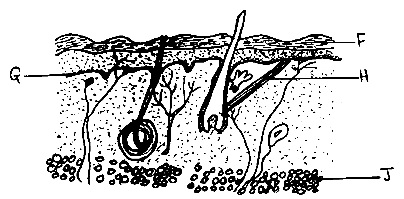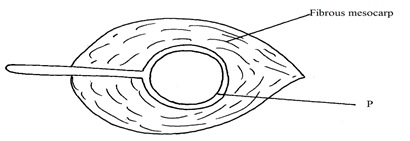Question 1
Name the organelle that performs each of the following functions in a cell
a) Protein synthesis
b) Transport of cell secretions
Answer
a) Protein synthesis - Ribosomes
b) Transport of cell secretions - Golgi apparatus / bodies
b) Transport of cell secretions - Golgi apparatus / bodies
Question 2
a) Define the term ‘parthenocarpy’.
b) Name two plant growth hormones that promote parthenocarpy.
Answer
a) Parthenocarpy - Process of food formation without fertilization.
b) 1. Auxins
2. Gibberillin
b) 1. Auxins
2. Gibberillin
Question 3
The diagram below shows a longitudinal section of mammalian skin.

a) Name the parts labelled F and G.
F
G
b) State one function of each of the parts labelled H and J
H
J
Answer
a)
F - Cornified layer
G - Malpighian layer
b) H - Contracts and relax to raise and lower hair follicles.
J - Storage of fats / insulation against heat loss.
G - Malpighian layer
b) H - Contracts and relax to raise and lower hair follicles.
J - Storage of fats / insulation against heat loss.
Question 4
a) State two characteristics used to divide the phylum Arthropoda into classes.
b) Name the class with the largest number of individuals in the phylum Arthropoda.
Answer
a) 1. Number of body parts
2. Number of legs
3. Presence and number of antenae.
b) Insecta
2. Number of legs
3. Presence and number of antenae.
b) Insecta
Question 5
The diagram below represents a longitudinal section of a fruit

a) Identify the mode of dispersal
b) Describe two adaptations of the fruit to its mode of dispersal
Answer
a) Water
b) 1. Has fibrous mesocap which store air to enable it to float.
2. Has though seed coat which is impermeable to water.
b) 1. Has fibrous mesocap which store air to enable it to float.
2. Has though seed coat which is impermeable to water.
